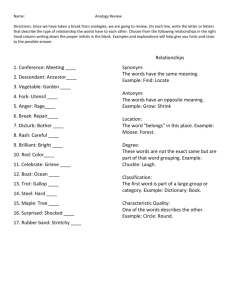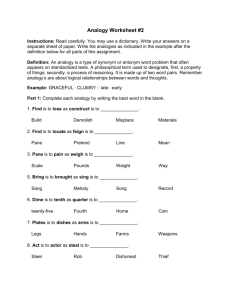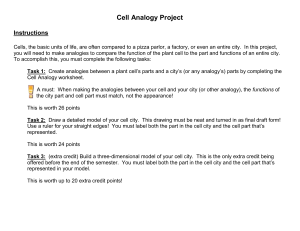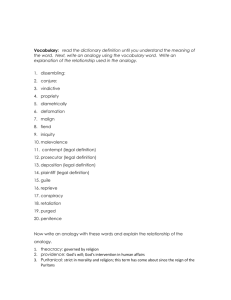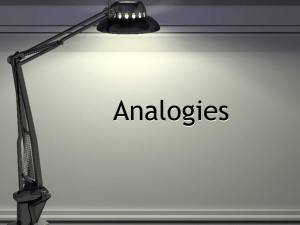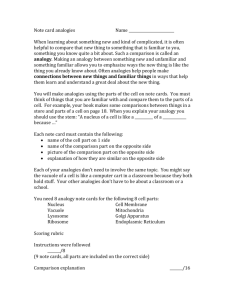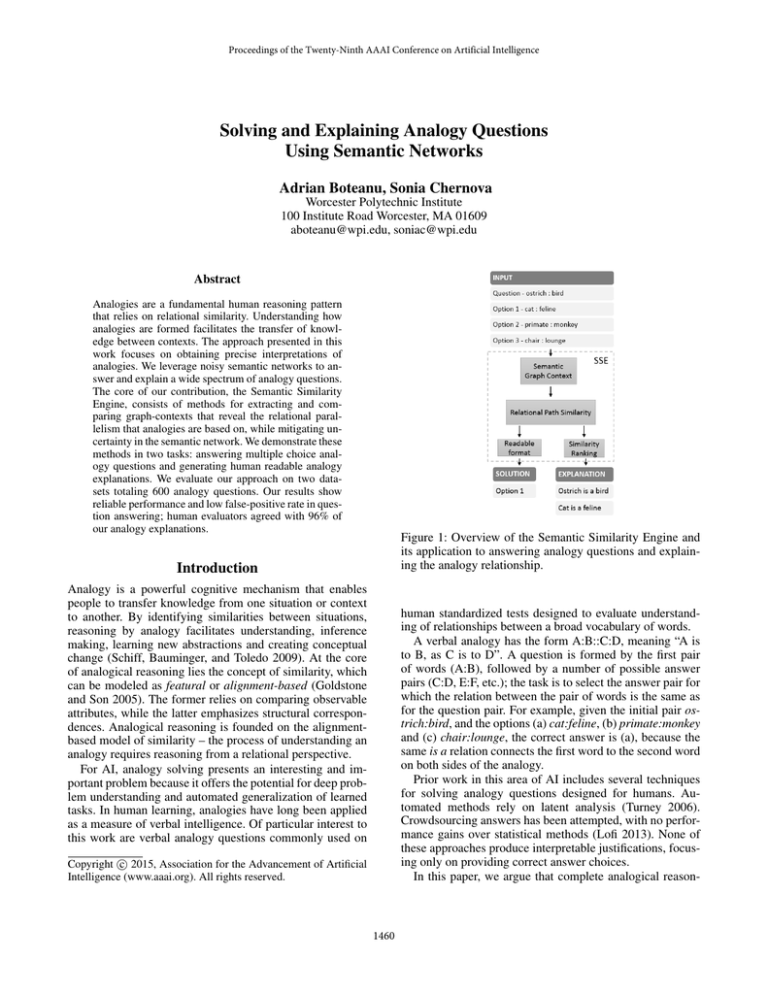
Proceedings of the Twenty-Ninth AAAI Conference on Artificial Intelligence
Solving and Explaining Analogy Questions
Using Semantic Networks
Adrian Boteanu, Sonia Chernova
Worcester Polytechnic Institute
100 Institute Road Worcester, MA 01609
aboteanu@wpi.edu, soniac@wpi.edu
Abstract
Analogies are a fundamental human reasoning pattern
that relies on relational similarity. Understanding how
analogies are formed facilitates the transfer of knowledge between contexts. The approach presented in this
work focuses on obtaining precise interpretations of
analogies. We leverage noisy semantic networks to answer and explain a wide spectrum of analogy questions.
The core of our contribution, the Semantic Similarity
Engine, consists of methods for extracting and comparing graph-contexts that reveal the relational parallelism that analogies are based on, while mitigating uncertainty in the semantic network. We demonstrate these
methods in two tasks: answering multiple choice analogy questions and generating human readable analogy
explanations. We evaluate our approach on two datasets totaling 600 analogy questions. Our results show
reliable performance and low false-positive rate in question answering; human evaluators agreed with 96% of
our analogy explanations.
Figure 1: Overview of the Semantic Similarity Engine and
its application to answering analogy questions and explaining the analogy relationship.
Introduction
Analogy is a powerful cognitive mechanism that enables
people to transfer knowledge from one situation or context
to another. By identifying similarities between situations,
reasoning by analogy facilitates understanding, inference
making, learning new abstractions and creating conceptual
change (Schiff, Bauminger, and Toledo 2009). At the core
of analogical reasoning lies the concept of similarity, which
can be modeled as featural or alignment-based (Goldstone
and Son 2005). The former relies on comparing observable
attributes, while the latter emphasizes structural correspondences. Analogical reasoning is founded on the alignmentbased model of similarity – the process of understanding an
analogy requires reasoning from a relational perspective.
For AI, analogy solving presents an interesting and important problem because it offers the potential for deep problem understanding and automated generalization of learned
tasks. In human learning, analogies have long been applied
as a measure of verbal intelligence. Of particular interest to
this work are verbal analogy questions commonly used on
human standardized tests designed to evaluate understanding of relationships between a broad vocabulary of words.
A verbal analogy has the form A:B::C:D, meaning “A is
to B, as C is to D”. A question is formed by the first pair
of words (A:B), followed by a number of possible answer
pairs (C:D, E:F, etc.); the task is to select the answer pair for
which the relation between the pair of words is the same as
for the question pair. For example, given the initial pair ostrich:bird, and the options (a) cat:feline, (b) primate:monkey
and (c) chair:lounge, the correct answer is (a), because the
same is a relation connects the first word to the second word
on both sides of the analogy.
Prior work in this area of AI includes several techniques
for solving analogy questions designed for humans. Automated methods rely on latent analysis (Turney 2006).
Crowdsourcing answers has been attempted, with no performance gains over statistical methods (Lofi 2013). None of
these approaches produce interpretable justifications, focusing only on providing correct answer choices.
In this paper, we argue that complete analogical reason-
c 2015, Association for the Advancement of Artificial
Copyright Intelligence (www.aaai.org). All rights reserved.
1460
in that it relies on one-to-one concept associations to form
analogies. However, SME relies on a hand-crafted ontology
(Cyc), while our methods are designed to be noise resilient,
allowing us to benefit from a broader, automatically generated data source (ConceptNet). Another key difference is
that both the input and output of our system are close to a
human readable form (Figure 1), making it easy to integrate
with natural language systems.
Additionally, previous approaches exist for uncovering
unknown relations in semantic graphs. SPARQL is a common query language for accessing RDF triplet stores expressing semantic information (Quilitz and Leser 2008).
SPARQL has been extended with queries that return the
most direct connection between two nodes (Kochut and
Janik 2007). Our context extraction method differs from this
in that it returns a set of concept-relation sequences of different length connecting the pair of words instead of the shortest path.
ing requires more than just the ability to select the correct
answer choice. Equally importantly, we believe an analogical reasoning system must be able to effectively model and
explain the mutual relationship that connects the pairs of
words. Toward this end, we contribute the Semantic Similarity Engine (SSE), a framework that leverages noisy semantic
networks to answer and interpret analogy questions.
Semantic networks are graphs in which words (or concepts) are represented in the nodes and the edges signify relations between them. Some networks are hand-crafted, for
example WordNet (Pedersen, Patwardhan, and Michelizzi
2004), while others are generated automatically from mining
documents. The key difference is that hand-crafted graphs
are more accurate, but represent a smaller number of concepts and types of relations. Conversely, mining produces
noisy graphs which express a broader set of concepts and relations. For evaluating analogies as diverse as those designed
for humans, we use ConceptNet (Speer and Havasi 2012),
a project which aggregates data from DBPedia, WordNet,
VerbNet and other sources. ConceptNet represents relations
of multiple types: lexical, functional, taxonomical, etc. In
this work we use all fixed form relations from ConceptNet,
46 in total. Relations are expressed as weighted directed
edges. Since it includes automatically generated data, ConceptNet has noise both in the nodes and in the edges.
Leveraging ConceptNet, we introduce techniques for
reducing the concept-relation search space by extracting
the graph context, evaluating relational sequence similarity within word pairs, answering questions using similarity
ranking across word pairs and generating human-readable
explanations for analogies. Figure 1 shows an overview of
our system. The input and output of our system are closer to
human-readable text than to structured representations, and
96% of human evaluators agreed with our analogy explanations.
Semantic Similarity Engine
Figure 1 shows the block diagram for SSE and how it
processes analogy questions. The system has two common
steps: extracting semantic contexts represented as graphs for
each pair of words, and computing sequence similarity. This
common core is then used for the tasks of explaining analogies and answering multiple choice questions.
Semantic Context Subgraph Extraction
The first stage of our pipeline is to extract the context defined
by a pair of words, which we refer to as the start words. The
goal of this stage is to model the relationship between the
start words by identifying multiple semantic paths between
them. We refer to chains of nodes and the relations connecting them as sequences, and define the context of a pair of
start words as a graph containing the start words and sequences of nodes and relations by which they are connected.
It may not be immediately clear why we are seeking to
identify multiple paths within the semantic network. In fact,
many word pairs in our analogy dataset are directly linked
by one (or more) of the 46 relationships within ConceptNet.
However, indirect paths through other nodes may provide
greater insight into the relationship of the start words themselves. Figure 2 presents an example of such a case, visualizing the graph extracted from ConceptNet for the word pair
goose:flock. The correct relation implied by the analogy is
part of, which is represented in the graph, but only for the
superclass of goose, i.e. bird. The start words goose and flock
are directly connected, but only through a less informative
related to edge, while both have stronger connections with
bird through is a and part of edges, respectively. It is therefore necessary to explore multiple paths of different lengths
in order to reason effectively about the relationship between
these words and find a good analogy explanation.
We generate the context graph for a given pair of start
words in two steps. First, we extract the unpruned semantic context. This is performed by recursively expanding concepts in breadth-first order starting from the start words,
caching a subgraph from the full semantic graph (i.e. Con-
Related Work
Prior work in this area has focused on answering multiple choice analogy questions via unsupervised latent analysis (Turney and Littman 2005; Turney 2006). Similar to
LSA (Hofmann 1999), the authors introduce Latent Relational Analysis (LRA), in which the relation formed by each
side of the analogy is modeled as a latent variable. Answers
are selected based on likelihood ranking. The peak performance of LRA on the SAT dataset (which we also use in our
work) is 56%. More recent approaches incorporate supervised learning, building on previous statistical methods (Turney 2013). We consider our work complementary to LRA, in
that we focus on providing explanations to analogies while
LRA is designed to answer multiple-choice questions and
does not offer interpretable answers.
The core of our work relates to evaluating similarity at
a relational level. The most closely related prior work is
that on the Structure Mapping Engine (SME), which enables
matching of relational characteristics between two semantic frames (Gentner 1983; Gentner et al. 1997). SME has
been applied in multiple contexts, including sketch classification (Chang and Forbus 2012) and games (Hinrichs and
Forbus 2007). Our approach has commonalities with SME
1461
Algorithm 1 Sequence similarity. s1 and s2 have the same
length, each connecting a pair of concepts in different contexts.
1: sim ← 1.0
2: for k in range(1, length(s1 ) − 1) do
3:
s1,k ← s1 [k : k + 1]
4:
s2,k ← s2 [k : k + 1])
5:
edges1 ← context1 .get rel types(s1,k [0], s1,k [1])
6:
edges2 ← context2 .get rel types(s2,k [0], s2,k [1])
7:
simk ← CommonRelP rop(edges1 , edges2 )
8:
sim ← sim ∗ simk
9: end for
10: return sim
Figure 2: Example context surrounding goose and flock. The
most meaningful sequece of relations is through an intermediate node, bird.
(a)
greatest number of common edges between two contexts.
For a pair of context-graphs, we identify the HSSP by iterating through all possible pairs of sequences of the same
length, one from each graph, and selecting the one with the
highest similarity score. Algorithm 1 presents the algorithm
for calculating the similarity score, which has a value between 0 and 1. For each sequence pair, s1 and s2 , the algorithm iterates over the length of the sequence (line 2). For
each segment, we compute the size of the set of common
relations relative to the total set of relations present on that
segment (lines 5-8). For example, comparing segments A–B
and C–D, linked by relations {p,q,r} and {r,p} respectively,
the similarity score becomes 2/3, because there are two relations in common out of three total relations for this segment.
At this stage, we do not yet take into account the weight or
direction of edges, as this makes the algorithm more resilient
to noisy edge additions or omissions within ConceptNet.
To generalize this algorithm for sequence pairs of arbitrary (but equal) length, we apply this metric to all segments
of the sequence and multiply the similarity scores (lines 8).
This ensures that if at any point the sequences are entirely
dissimilar, the overall similarity is zero.
(b)
Figure 3: Unpruned (a) and pruned (b) context graphs.
ceptNet). The entire graph is too large (tens of GB) to be accessed efficiently without caching. The stopping condition
is a limit on the number of explored concepts. At each node
addition in the breadth-first exploration, we test if there are
edges to or from the rest of the nodes in the context-graph,
and add them if so. This ensures that all existing relations
between the context’s words are captured. Figure 3(a) shows
an unpruned graph example.
If the search fails to find a sequence between the start
words, then analogical comparisons with another graph are
not possible. This occurs for 14% of the word pairs within
our dataset when using a 500 word limit for expansion.
Using a larger limit did not impact results. Additionally,
attempting to identify long sequences connecting the start
words does little to aid the analogy solving or explanation
process, since long sequences become difficult to interpret.
The context graph contains many leaf nodes that are irrelevant to the analogy. In the second step, we prune the graph
by removing any nodes that are not part of a sequence between the start nodes. Edge direction and weight are ignored
at this step. The result is a much smaller graph, typically
consisting of tens of nodes, as illustrated in Figure 3(b).
Modeling Analogies through SSE
The methods presented in the previous section allow us to
find the best common relational link between two different
pairs of words by searching a large semantic network. In this
section, we describe two applications for understanding the
relationship between word pairs: solving analogy questions
and explaining analogies.
Answering Analogy Questions
Our approach to solving analogy questions stems directly
from the similarity score obtained from the SSE. Our questions take the form presented in Figure 1. To select an answer, we first compute the HSSP between the question word
pair and each possible answer. Then, we rank all answer options by their respective HSSP score and select the one with
the highest score.
Options that have a similarity score of 0, or for which a
context-graph connecting the pair of words can not be found,
are discarded. We can then use the sequence pair that generated the similarity value (i.e. HSSP) to explain the analogy,
Sequence Similarity
Now that we have a method for extracting the pruned context
subgraph for any single pair of start words, we describe how
two such contexts can be compared to determine the similarity in the relation between them. Specifically, we present
an algorithm for identifying the highest similarity sequence
pair (HSSP), the sequence of nodes and edges that has the
1462
Algorithm 2 Generating a human-readable explanation
from the best similarity sequence pair, which have the same
length.
1: sq ← question seq; sa ← answer seq
2: eq ← [ ]; ea ← [ ]
3: n ← length(questions eq)
4: for k in 0...(n − 1) do
5:
eq.append(sq[k]); ea.append(sa[k])
6:
for rel in ∩(sq[k : k+1].edges, sa[k : k+1].edges)
do
7:
support[rel] = min(sq[k, k + 1].rel.weight,
sa[k, k + 1].rel.weight))
8:
end for
9:
rel max ← rel f or which max(support[:])
10:
eq.append(rel max); ea.append(rel max)
11: end for
12: eq.append(sq[n]); ea.append(sa[n])
13: return convert to english(eq, ea)
as discussed in the following section.
In the results presented in this paper, we do not attempt to
answer the question if there are no answers with a similarity score greater than 0. It is trivial to extend our technique
to allow the algorithm to simply guess one of the multiple
choice options. We do not utilize random guessing in this
paper both to more accurately reflect the performance of the
algorithm, and to facilitate our main goal of studying how
the relationship behind the analogy can be explained. An answer obtained through guessing would make our algorithm,
just as a human student, unable to explain the similarity between the two word pairs.
Explaining Analogies
Established practices for teaching human students to solve
analogies instruct them to do so by forming a full sentence
that clearly shows the relationship between the two question
words, and then forming a second sentence that shows a similar relationship for their chosen answer word pair. The aim
of our work is to generate the sentences that describe these
relationships automatically.
If two pairs of words are stated to be an analogy, we can
produce an interpretation from the corresponding HSSP. In
order to obtain output that is easily readable, we need to reduce the HSSP from having multiple relations per segment
to a single chain of relations (Algorithm 2). Therefore, we iterate through each segment along the sequences (line 4), and
choose the salient common edge between the two sides of
the analogy (lines 6-10), appending it to the explanation pair
along with the corresponding concepts (lines 5, 10). Note
that edge direction is taken into account in these steps.
We select the common relation with the highest
minimum-weight, preventing imbalances in which only one
side of the analogy is strongly related while the other is relatively weak. Figure 4 shows and example, in which the
bolded relations are selected according to Algorithm 2.
Results
We evaluate the SSE’s ability to correctly answer and explain analogies using two datasets:
• 373 questions used in SAT US college admittance tests.
This dataset was also used in previous work on answering analogies (Turney and Littman 2005); Table 1 shows
question examples;
• 227 questions from a public domain website1 targeted
for grades 1-12. We combine these into four groups: elementary school (grades 1-4), middle school (grades 5-8)
and high school (grades 9-12), containing 120, 60, and 47
questions, respectively.
In both datasets, each multiple choice question contains five
possible answers. Combined, these questions form a progression of increasingly difficult analogy problems.
Question Answering Performance
In this section, we evaluate the SSE’s performance in answering questions. We track two performance metrics:
1. answer attempt proportion, which represents the number of questions for which our algorithm selected an answer. As discussed earlier, our system attempts to answer
a question only if there is at least one answer for which
the HSSP has a non-zero similarity score, thus preventing
random guessing.
Figure 4: Starting from HSSP, we select the common salient
edge on each segment to produce human-readable explanations. eq and ea are then converted to English.
2. answer correctness proportion, which represents how
many of the attempted questions were answered correctly.
In our analysis, we limited the semantic context subgraphs
to have a maximum geodesic distance of two. The geodesic
distance is the shortest distance between two vertices in the
graph, measured in number of edges. Longer paths, while
feasible, proved to result in few answer attempts. In the results, we separately report performance for solutions with
Once a relation is selected for each segment, we convert
the resulting list of nodes and relations into English using a
dictionary which maps coded relations names to more readable versions (line 13). For example, a PartOf edge translates to “is a part of.” While more sophisticated methods
can be used to generate explanation phrases, grammatical
correctness it is not the focus of our work; human evaluators
were asked not to assess grammatical correctness.
1
Section “Unit 2: Read Theory Word Pair Analogies” from http:
//www.englishforeveryone.org/Topics/Analogies.htm
1463
Table 1: Question examples from the SAT dataset and the answer results of our approach (correct answers shown in bold).
QUESTION
custom:society
seed:plant
lull:trust
virtuoso:music
querulous:complain
audacious:boldness
OPTION A
hypothesis:evidence
pouch:kangaroo
balk:fortitude
bard:poetry
silent:talk
anonymous:identity
OPTION B
testimony:trial
root:soil
betray:loyalty
crescendo:scale
humorous:laugh
remorseful:misdeed
OPTION C
ballot:election
drop:water
cajole:compliance
lyricist:melody
dangerous:risk
deleterious:result
OPTION D
rule:game
bark:tree
hinder:destination
portrait:photography
deceitful:cheat
impressionable:temptation
OPTION E
contest:debate
egg:bird
soothe:passion
critic:performance
gracious:accept
sanctimonious:hypocrisy
ATTEMPTED
yes
yes
yes
yes
no
no
CORRECT
yes
yes
no
no
-
attempted question is higher than in the original condition,
providing a means of regulating the algorithm’s behavior in
focusing more or less on accuracy vs. attempts.
In summary, the results demonstrate that the SSE-based
methods for analogy solving achieve high accuracy in this
difficult domain, but sacrifice coverage by not attempting
to answer questions which would require the algorithm to
guess. We made this design choice due to our focus on explaining analogy questions, which requires the ability to accurately model the relationship between word pairs. We discuss our results for generating explanations in the following
section.
a distance of 1, which we call direct, and those with a distance of two, which we call one-hop, to demonstrate the frequency of occurrence and reliability of both cases. We show
results separately because an answer may be available for
each path length. These answers could be combined via ensemble methods to increase the answer attempt proportion,
but that extension is outside the scope of this paper.
Additionally, to establish how well the SSE measures similarity, we compare against a baseline approach that relies on
ConceptNet’s own metric for similarity provided by the Divisi toolkit (Speer, Arnold, and Havasi 2010). This metric is
a real number between 0 and 1, calculated using the SVD
within ConceptNet. In this experimental condition we performed question answering as follows: for each pair of start
words, we computed the Divisi similarity value; we selected
the answer for which the similarity was numerically closest to the similarity of the question pair, attempting answers
only if the question and at least one answer had non-zero
similarity.
Figure 5(a) presents answering performance for direct,
one-hop and baseline methods over the analogy data set. The
solid line shows the proportion of attempted questions, while
the histogram presents the proportion of correct answers of
each method. Across all four question levels, the baseline
technique attempts to answer a large percentage of questions, but has low accuracy. Its best performance is on the
elementary school data set, where it achieves 28% accuracy.
By comparison, both SSE conditions (direct and one-hop),
are less likely to attempt an answer, but have a significantly
higher accuracy.
In the elementary grade data set, the direct solver achieves
an accuracy of 85%. While performance declines as question
difficulty increases, both solvers answer correctly 83% of attempts on average in the 1-12 grade dataset. As questions become more difficult, especially for the SAT dataset, knowledge of the words’ meanings becomes key. SAT questions
often focus on rarely encountered words, so it is unsurprising that the attempt ratio decreases due to lack of connections between the start words. Despite this, the SSE methods
achieve answer correctness of 40% on the SAT dataset.
The experimental results presented in Figure 5(a) were
obtained by utilizing all 46 relations found in ConceptNet.
In Figure 5(b) we present similar results for a second condition in which we ignore two relation types, RelatedTo and
ConceptuallyRelatedTo, which are unique within ConceptNet because they are derived statistically from document cooccurrence and thus are far more noisy. Moreover, they are
not useful for generating explanations. In this condition we
note that the attempt proportion is lower, since many edges
within the context are ignored. However, the accuracy for
Explanation Performance
The ultimate goal of our system is to generate full sentence,
human readable explanations of analogy question solutions.
To evaluate our success, we surveyed people to test whether
the explanations generated by our algorithm were meaningful to them. We conducted our survey through the CrowdFlower crowdsourcing market using the 74 explanations (60
direct, 14 one-hop) produced by SSE from the correct answers selected when ignoring RelatedTo and ConceptuallyRelatedTo edges.
For each explanation, the survey first presented the corresponding analogy question in its full form, including the
question statement and all possible answers (as in Figure
1). Then we told readers the true answer, followed by the
explanation. Participants were asked to choose whether the
explanation correctly justified the answer.
To evaluate the quality of our explanations, and to ensure
that human readers were paying attention, we ran this study
by randomly interleaving examples from three conditions:
1. SSE-generated explanations - an explanation generated
from a HSSP selected by SSE;
2. randomized explanations - we substituted the relations in
the SSE-generated set with random selections from the set
of 44 relations;
3. edited explanations - we substituted the relations in the
SSE-generated set with manually edited relations that
were contradictory to the true relation.
Table 2 presents examples of all three explanation types.
We included the randomized and edited conditions in our
analysis because many relations within ConceptNet are similar, and thus selecting one at random may result in a relation
that was very close, but not identical to, the SSE-selected
one. Our goal was to verify that the SSE-selected relations,
and the explanations derived from them, were clearly correct and differentiable from both random noise and wrong
answers.
1464
Figure 6: Evaluation of explanation quality for direct (D)
and one-hop paths (1H), comparing our system’s output (C)
with randomized (R) and edited (E) conditions.
(a)
Table 2: Question examples from the SAT dataset and the
answer results of our approach (correct answers in bold).
Solver
Dataset
Direct
SSE-selected
Direct
Randomized
Direct
Edited
One-hop
SSE-selected
One-hop
Randomized
One-hop
Edited
Explanation Pair
fire has property of hot
ice has property of cold
fire is a member of hot
ice is a member of cold
fire is not hot
ice is not cold
tub is used for bath, which is at location bathroom
stove is used for cook, which is at location kitchen
tub is located near bath, which is attribute of bathroom
stove is located near cook, which is attribute of kitchen
tub is participle of bath, which inherits from bathroom
stove is the participle of cook, which inherits from kitchen
(b)
Figure 5: Answer performance on four datasets, comparing the direct (D) and one-hop (1H) methods with the Divisi similarity baseline (S) both when using (top) and when
ignoring (bottom) statistically derived relations. Questions
are grouped by elementary grades (G1-G4), middle school
grades (G5-G8), high school (G9-G12) grades and SAT.
Finally, we note that the relatively strong performance of
the randomized dataset suggests that humans were less sensitive to the exact wording of the analogy explanation and
accepted relatively close relation substitutes, as long as the
substituted relation was sufficiently similar to the one intended by the analogy. This result has broader implications,
as it suggests that correctly identifying the ideal relation represented by the analogy may not be necessary. Computationally, the set of all possible analogy relations is potentially
very large. However, if we allow for approximations, multiple analogy relationships can be collapsed, a hypothesis that
is supported by these results.
In total, the surveys tested 222 explanations (three study
conditions applied to 74 questions), and each question received at least 5 judgements (5.79 on average). Figure 6
reports the proportion of analogy explanations that participants considered to be valid for each condition, reported
separately for direct and one-hop solvers. We observe that
human evaluators agreed with 96% of the explanations produced by our method – all but a single one-hop explanation were accepted. Approximately half of the randomly selected explanations were considered valid, and we observed
higher disagreement between participants in this dataset
(study-wide inter-user agreement was high, 87% on average, but only 78% for randomized condition). When analyzing these instances case by case, we found many of the
randomly selected explanations to be reasonable, if not entirely sound. However, in the edited dataset, which contained
intentionally illogical relations, very few were considered
valid. This result strongly supports the validity of the SSEgenerated similarity relationships and the analogy explanations founded upon them.
Conclusion
Analogies are an essential reasoning pattern that enables
learning through similarity and skill transfer. In this work,
we presented a method for evaluating analogical similarity by comparing paths within semantic context graphs derived from large scale noisy semantic networks. We demonstrated the effectiveness of our approach on two applications, solving multiple choice analogy questions and generating human-readable explanations for the analogies. Our
results demonstrate that our methods achieve high accuracy
in correctly answering attempted questions, and surveyed
study participants agreed with the analogy explanations generated by our algorithm in 96% of cases. In future work, we
plan to explore the use of semantic similarity in other domains, including scene understanding and skill transfer.
1465
References
Chang, M. D., and Forbus, K. D. 2012. Using quantitative information to improve analogical matching between
sketches. Innovative Applications of Artificial Intelligence
(IAAI). Toronto, Canada.
Gentner, D.; Brem, S.; Ferguson, R. W.; Markman, A. B.;
Levidow, B. B.; Wolff, P.; and Forbus, K. D. 1997. Analogical reasoning and conceptual change: A case study of
johannes kepler. The journal of the learning sciences 6(1):3–
40.
Gentner, D. 1983. Structure-mapping: A theoretical framework for analogy*. Cognitive science 7(2):155–170.
Goldstone, R. L., and Son, J. Y. 2005. Similarity. Cambridge
University Press.
Hinrichs, T. R., and Forbus, K. D. 2007. Analogical learning
in a turn-based strategy game. In IJCAI, 853–858.
Hofmann, T. 1999. Probabilistic latent semantic analysis.
In Proceedings of the Fifteenth conference on Uncertainty
in artificial intelligence, 289–296. Morgan Kaufmann Publishers Inc.
Kochut, K. J., and Janik, M. 2007. Sparqler: Extended sparql
for semantic association discovery. In The Semantic Web:
Research and Applications. Springer. 145–159.
Lofi, C. 2013. Just ask a human?–controlling quality in relational similarity and analogy processing using the crowd.
In BTW Workshops, 197–210.
Pedersen, T.; Patwardhan, S.; and Michelizzi, J. 2004.
Wordnet:: Similarity: measuring the relatedness of concepts.
In Demonstration Papers at HLT-NAACL 2004, 38–41. Association for Computational Linguistics.
Quilitz, B., and Leser, U. 2008. Querying distributed RDF
data sources with SPARQL. Springer.
Schiff, R.; Bauminger, N.; and Toledo, I. 2009. Analogical
problem solving in children with verbal and nonverbal learning disabilities. Journal of Learning Disabilities 42(1):3–13.
Speer, R., and Havasi, C. 2012. Representing general relational knowledge in conceptnet 5. In LREC, 3679–3686.
Speer, R.; Arnold, K.; and Havasi, C. 2010. Divisi: Learning
from semantic networks and sparse svd. In Proc. 9th Python
in Science Conf.(SCIPY 2010).
Turney, P. D., and Littman, M. L. 2005. Corpus-based learning of analogies and semantic relations. Machine Learning
60(1-3):251–278.
Turney, P. D. 2006. Similarity of semantic relations. Computational Linguistics 32(3):379–416.
Turney, P. D. 2013. Distributional semantics beyond words:
Supervised learning of analogy and paraphrase. arXiv
preprint arXiv:1310.5042.
1466

